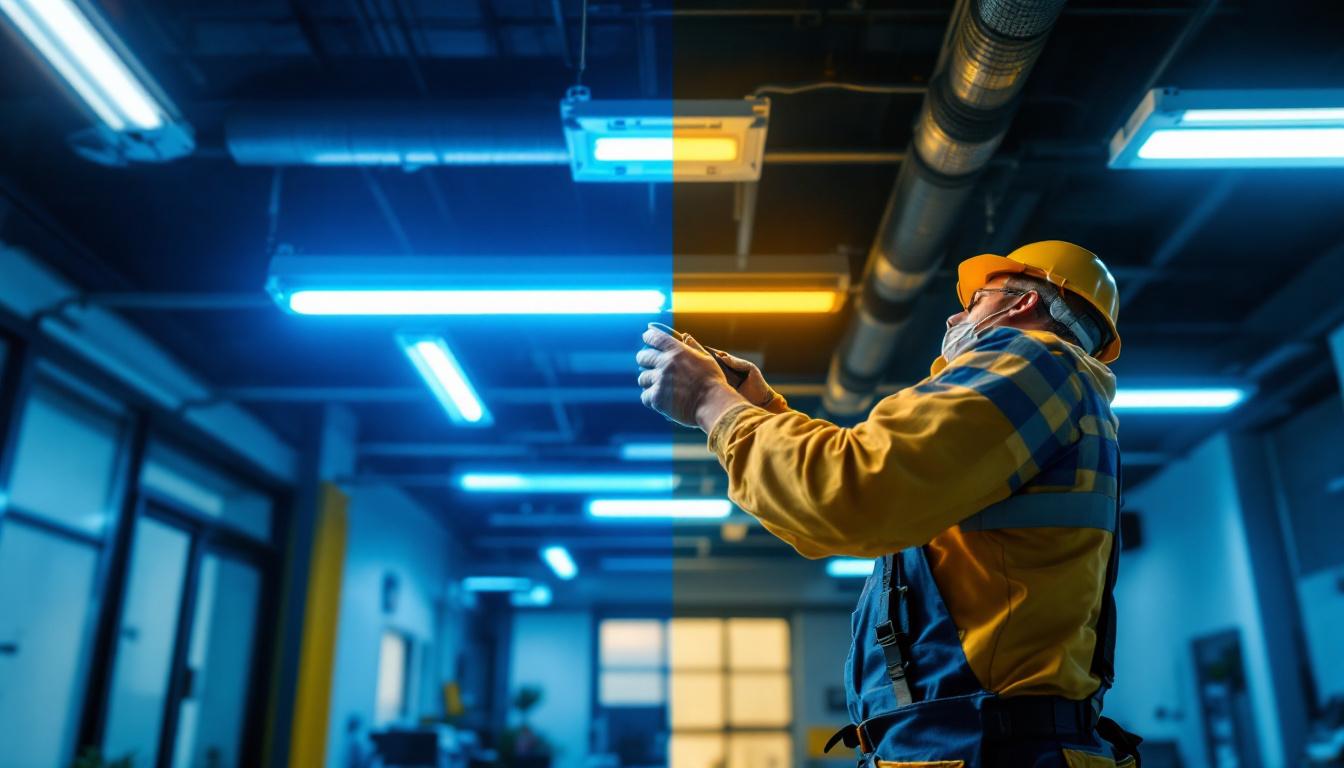
The transition from T12 fluorescent lamps to LED lighting has become a significant trend in the lighting industry. As energy efficiency and sustainability take center stage, lighting contractors are increasingly tasked with converting outdated lighting systems to more modern, efficient alternatives. This article explores the implications of converting T12 to LED lighting, focusing on its impact on lighting contractors’ projects.
Upgrading from T12 to LED lighting is not merely a matter of replacing bulbs; it is a strategic decision that can enhance the overall quality of lighting while offering numerous benefits. Understanding these advantages is crucial for lighting contractors as they navigate their projects.
One of the most compelling reasons to switch from T12 to LED is energy efficiency. LEDs consume significantly less power than traditional fluorescent lamps, leading to lower energy bills for clients. This reduction in energy consumption not only benefits the client’s bottom line but also aligns with broader environmental goals by reducing carbon footprints.
Moreover, the efficiency of LEDs means they produce more lumens per watt compared to T12 fixtures. This higher output allows for better lighting quality without the need for additional fixtures, making it an attractive option for contractors looking to maximize value. In fact, many municipalities offer incentives for businesses that make the switch to energy-efficient lighting, further enhancing the financial appeal of LED upgrades.
LEDs have a much longer lifespan than T12 bulbs, often lasting up to 25,000 hours or more. This longevity translates to fewer replacements and less maintenance, which is a significant advantage for both contractors and clients. For contractors, reduced maintenance means less time spent on service calls and more time dedicated to new projects.
Additionally, the durability of LEDs means they are less prone to breakage and failure, further minimizing maintenance concerns. This reliability can enhance a contractor’s reputation as clients appreciate the reduced hassle of frequent bulb replacements. Furthermore, many LED products come with warranties that can last several years, providing clients with peace of mind and further solidifying the value of their investment.
LED lighting offers superior quality compared to T12 fluorescent lamps. With options for adjustable color temperatures and improved color rendering indexes (CRI), contractors can provide tailored lighting solutions that meet specific client needs. This flexibility allows for a more customized approach to lighting design, enhancing the aesthetic appeal of spaces.
Furthermore, the instant-on capability of LEDs eliminates the flickering and warm-up time associated with T12 bulbs, providing immediate illumination. This feature is particularly beneficial in commercial settings where consistent lighting is crucial for productivity and safety. Additionally, the ability to dim LEDs without sacrificing efficiency opens up new opportunities for creating dynamic lighting environments that can adapt to various activities and moods throughout the day, from bright task lighting to softer ambient settings for relaxation or social gatherings.
As the demand for smart lighting solutions grows, many LED systems are now compatible with advanced technologies such as smart controls and automation. This integration allows for remote management and scheduling, enabling clients to optimize their lighting usage based on occupancy and time of day. Such features not only contribute to energy savings but also enhance the overall user experience, making LED upgrades a forward-thinking choice for any lighting project.
While the benefits of converting T12 to LED are clear, the process is not without its challenges. Lighting contractors must navigate various obstacles to ensure a successful transition for their clients.
One of the primary challenges faced by contractors is compatibility with existing fixtures. Not all T12 fixtures are designed to accommodate LED tubes directly. In some cases, retrofitting may be necessary, which can involve additional costs and labor. Contractors must assess each project individually to determine the best approach, whether that means replacing fixtures or using compatible LED tubes.
Additionally, some older fixtures may require modifications to meet current electrical standards, adding another layer of complexity to the conversion process. Understanding these compatibility issues is essential for contractors to provide accurate estimates and timelines to clients.
Although LED lighting offers long-term savings, the initial investment can be a barrier for some clients. Lighting contractors must effectively communicate the value of the upgrade, emphasizing the long-term energy savings and reduced maintenance costs. Providing a clear breakdown of costs and potential savings can help clients justify the upfront expense.
Furthermore, contractors may need to explore financing options or incentives available for energy-efficient upgrades. Understanding local regulations and utility programs can empower contractors to offer clients a range of financial solutions, making the transition more accessible.
As the lighting industry evolves, ongoing education and training become vital for contractors. Staying informed about the latest LED technologies, installation techniques, and industry standards is essential for providing high-quality service. Contractors should invest in training programs and workshops to ensure their teams are well-equipped to handle LED conversions.
Moreover, educating clients about the benefits and features of LED lighting can enhance their overall experience. By becoming a trusted resource for information, contractors can build stronger relationships with clients and position themselves as industry leaders.
To navigate the complexities of converting T12 to LED successfully, lighting contractors can implement several strategies that streamline the process and enhance client satisfaction.
Before initiating a conversion project, it is crucial for contractors to conduct a thorough assessment of the existing lighting system. This evaluation should include an analysis of the current fixtures, wiring, and layout. By understanding the specific needs and challenges of each project, contractors can develop tailored solutions that maximize efficiency and effectiveness.
Additionally, engaging with clients during this assessment phase fosters collaboration and ensures that their preferences and requirements are taken into account. This collaborative approach can lead to more successful outcomes and increased client satisfaction.
Lighting contractors should aim to provide comprehensive solutions that encompass not only the installation of LED lighting but also any necessary retrofitting or upgrades to existing fixtures. By offering a complete package, contractors can streamline the process for clients and reduce the likelihood of complications arising during installation.
This holistic approach can also enhance the contractor’s reputation as a one-stop-shop for lighting solutions, making it easier to attract new clients and retain existing ones.
The use of technology and tools can significantly improve the efficiency of conversion projects. Lighting design software can help contractors visualize the new lighting layout and make informed decisions about fixture placement and specifications. Additionally, project management tools can assist in tracking timelines, budgets, and communication with clients.
By leveraging technology, contractors can enhance their productivity and ensure that projects are completed on time and within budget. This efficiency not only benefits the contractor but also leads to a more positive experience for clients.
The trend toward LED lighting is likely to continue as more businesses and homeowners recognize the benefits of energy efficiency and sustainability. Lighting contractors must stay ahead of the curve by adapting to emerging technologies and evolving client expectations.
As the lighting industry progresses, new technologies will continue to shape the landscape. Smart lighting systems, which allow for remote control and automation, are gaining popularity. Contractors should familiarize themselves with these advancements and consider how they can incorporate them into their offerings.
Additionally, advancements in LED technology, such as tunable white lighting and improved color rendering, will provide contractors with even more options for meeting client needs. Staying informed about these developments will be crucial for contractors looking to remain competitive in a rapidly changing market.
As the demand for LED conversions grows, so does the need for client education. Lighting contractors should prioritize informing clients about the benefits of LED lighting and the conversion process. This can be achieved through informative materials, workshops, or one-on-one consultations.
Engaging clients in discussions about their lighting needs and preferences can lead to more successful projects and increased client loyalty. By positioning themselves as knowledgeable partners in the conversion process, contractors can foster trust and build long-lasting relationships.
Ultimately, the shift from T12 to LED lighting is not just about improving energy efficiency; it is about contributing to a more sustainable future. Lighting contractors play a vital role in this transition by helping clients make informed choices that benefit both their businesses and the environment.
By embracing the conversion to LED lighting, contractors can position themselves as leaders in the industry, driving positive change and promoting sustainable practices. This commitment to sustainability will not only enhance their reputation but also attract clients who value environmentally responsible solutions.
The conversion from T12 to LED lighting presents both challenges and opportunities for lighting contractors. By understanding the benefits of LED technology, addressing compatibility issues, and implementing effective strategies, contractors can successfully navigate this transition. As the demand for energy-efficient lighting solutions continues to grow, those who adapt and embrace these changes will thrive in the evolving lighting landscape.
Ultimately, the shift to LED lighting is not just a trend; it is a pivotal moment in the lighting industry that holds the potential to reshape the way contractors approach their projects. By prioritizing education, innovation, and sustainability, lighting contractors can ensure their success in a competitive market while contributing to a brighter, more efficient future.
Ready to take on the LED conversion challenge and lead the way in energy-efficient lighting solutions? LumenWholesale is here to support you every step of the way. Our extensive selection of spec-grade lighting products is designed to meet the highest industry standards, ensuring that you deliver reliable and high-performance lighting for every project. With unbeatable wholesale prices and the convenience of free shipping on bulk orders, you can provide your clients with top-quality lighting without the burden of inflated costs. Don’t let hidden fees or compromises dim your project’s success. Choose LumenWholesale for the perfect blend of quality, affordability, and convenience. Take the next step in sustainable lighting and explore our wholesale lighting options at the best value today.

Explore how outdoor LED patio lighting transforms your backyard into an energy-efficient oasis.

Discover how lighting contractors can elevate their projects and increase profitability by integrating solar outdoor lights.

Learn how to train your team in lighting with our expert guide on exterior light sockets.

Illuminate your projects with ease using our comprehensive guide on construction string lights.